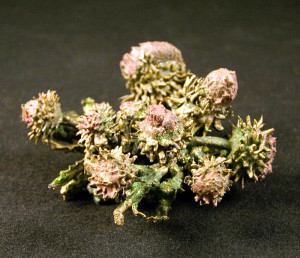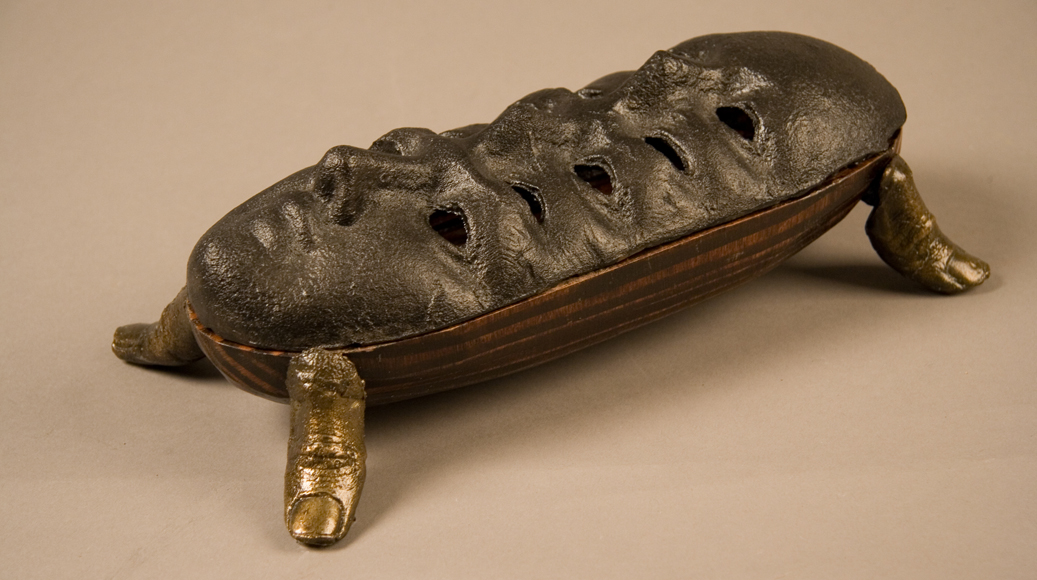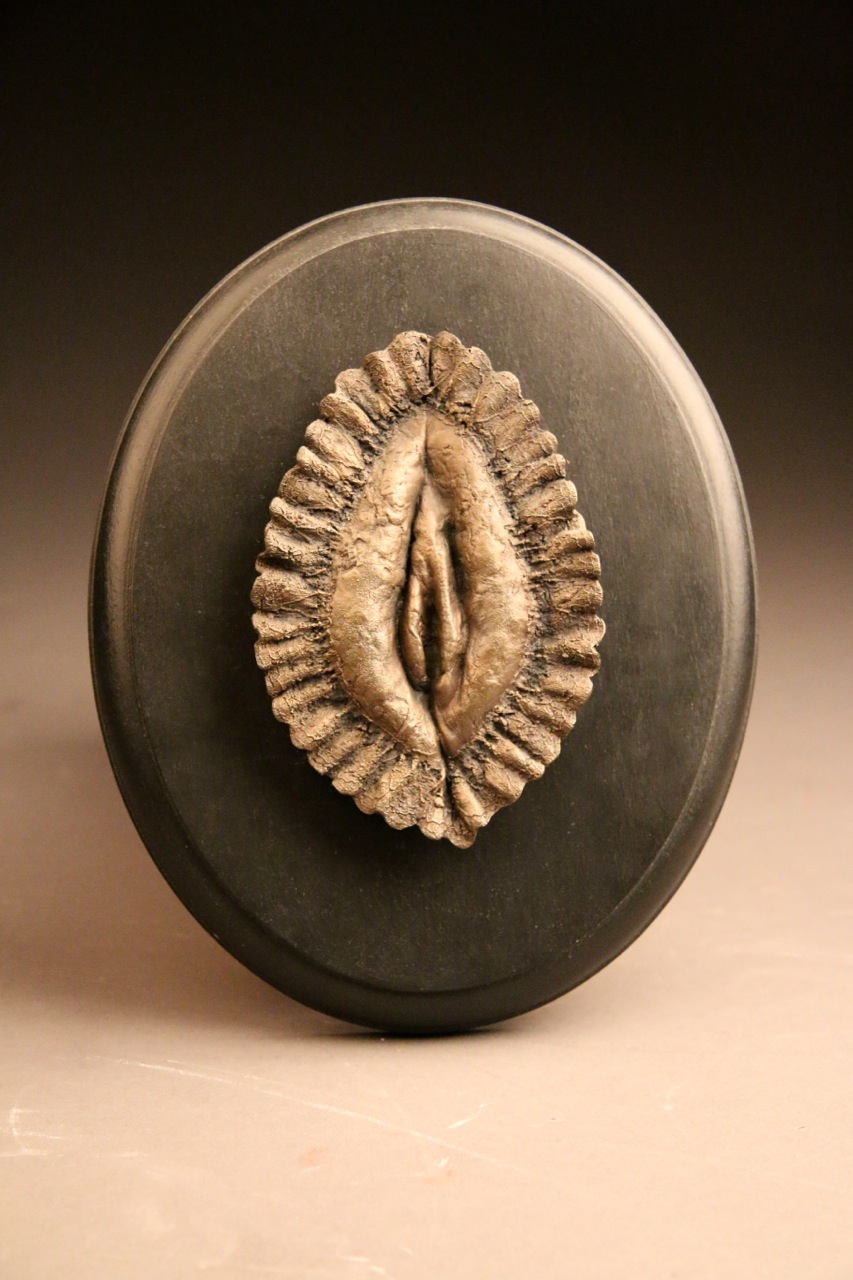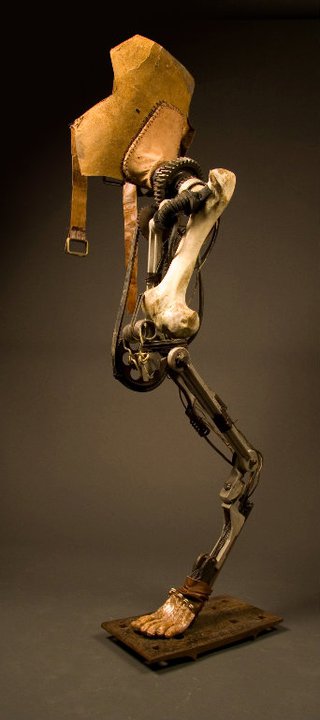 Mission: (Project Description)
Mission: (Project Description)
Hollow lost wax casting method: A unique wax pattern will be developed using plaster and rubber molds. The wax pattern will be taken through the “Lost Wax Process” to create a unique bronze or aluminum sculpture with a patina or alternative finishing method. Individual students have a choice to cast a wax form presented from a previous course or to create a new hollow casting for this project. A hollow lost wax casting method is the only technical criteria. If a new casting is to be produced, you are encouraged to create a composition and concept that pushes the envelope of this level course.
This project will challenge and further introduce the student to the processes of casting metal. A traditional investment material of plaster, silica sand and silica flour will be used for this project. The student should show an understanding of the methods listed below. A metal form will be cast and finished by the student.
Assignment:
For this assignment you are asked to build a 3- dimensional sculpture using at least three different wax elements. Wax welding will be used to bring these forms together in a well developed composition. You are encouraged to develop a sculpture that projects this level course. Create a form that suggest a concept that will engage your audience. Keep in mind that you should make some formal and technical decisions about visual balance, weight, interior and exterior form, proportion and other elements of design.
• Create a wax pattern. Plaster and rubber molds may be utilized.
• Include a hollow form in the composition.
• Assemble wax composition pattern from multiple wax objects.
• While building, consider casting methods and techniques, air traps, venting strategies.
• Create wax gating and runners from plaster molds.
• Create string vents.
• Gate, vent and prepare wax pattern to be cast.
• Prepare investment flask and chicken wire support.
• Invest wax pattern in Plaster/Silica Sand/Silica flour Investment mold.
• Wax will be burned out in kiln, This s a three day process. Plan for this in advance.
• Cast object in metal: This will be a team coordinated effort.
• De-invest pattern from investment mold.
• Remove gating from the casting.
• Metal Finish: Fasten or weld if necessary, chasing, grinding and filing.
• Metal Finish: “Patina”, chemical treatment of metal surface.
• Seal the form in wax or other finish.
Reliquary Component: (Optional)
Build a reliquary for your final chosen object. This reliquary can take on many forms but should house your form with absolute intent. The marriage between object and reliquary should make sense and have a good balance to focus the audience towards your work. Again craft is very important. Below is a list of types of reliquary objects and materials acceptable for the project.
• Wood: Sculpted, hollowed out, or fabricated wood structures
• A well designed/crafted crate may be fabricated as well.
• Plaster, plastic or wax castings of the body or other objects.
• Note: Plaster can be sculpted cast and hollowed out to hold an artifact.
• Installations: Consider the idea that a reliquary is much like a shrine
• Metals fabrication/containers
• Glass
• Plastics
• Books: Sculpted, hollowed out, or fabricated structures
• Paper, books, and cardboard:
It is expected that the concept and fabrication of the reliquary and the marriage to the object, be convincing. Challenge yourself to meet the aesthetic and craft related to your object or concept and to the echelon of this course.
Craft:
Set yourself up for success. Craftsmanship should be strongly considered in developing a “good” pattern. Strive for craftsmanship even in the gating system. These considerations will make de-gating and finishing a much easier task once the form is in metal. Take care and don’t rush the process and the process will work for you rather than against you.
Hot Wax:
Wax is very hot, be careful in handling molds during casting and when welding wax. Red casting wax temperature should be between 250 and 300 degrees F. Do not let wax smelter get too shallow. If there is no wax to fill it, turn it off. Wax should be left on continuously during our use. If you are the last one in the studio and leaving for the day, turn it down to 250 degrees F.
Alternative Materials:
Other material may be explored with instructor approval.
- Natural Materials (Use your imagination)
- Cotton cloth
- Wood
- 3d printed PLA and ABS
Larger Forms and Post Fabrication:
Scale: The sculpture scale is limited to the designated size in which the foundry can accommodate for this class. Plan ahead, measure the size of the burn-out kiln before you create a mold that will be too large for the kiln interior volume. Forms can be post fabricated. Think ahead. Think Modular. Design larger forms with smaller components that can be cast and fastened together to create the final larger form. Post fabrication techniques includes tap and die, screwing, bolting, keyed, welding, etc.
Kiln: You should keep a three inch perimeter around your mold away from the kiln interior wall to allow an even distribution of heat around the mold. Allow 6 inches of space for height. Shelving or kiln brick should be used to support your mold off the kiln floor. Kiln should be vented to allow moisture and carbon to escape.
Clean-Up Reminders:
Wax Work:
Cover the table surface when using wax: Use thick plastic, metal or cardboard to cover the tables and work areas. If these are unavailable cover your work area with newspaper.
Plaster Work:
Use newspaper to protect the table surfaces.
Investment:
A traditional investment material of plaster, sand and silica flour will be used for this project. To assist in clean up a layer of cardboard may be placed under your investment flask. Clean up accordingly, removing waste to dumpster behind sculpture.
Metal pour:
As a team you all will be in charge of coordinating and implementing metal pours. Primarily, your instructor will be available to assist in some process and technical questions and to observe. All pours should be scheduled during class times.
De-Investing:
When de-investing, remove the waste material to the dumpster. This material gets too heavy for one person to clean up. A metal garbage can, hand truck or cart may be used to transport the material to the dumpster. Just remember, If you make a mess, clean it up!
Wear appropriate clothing during foundry pours.
• Cotton clothing, pants and shirt.
• Leathers or Fire resistant suits
• Safety Glasses
• Safety shield
• Hard Hat-welding cap
• Leather covered shoes (Steel toed preferred)
• Leather chaps or leggings
• Leather spats
• No Poly blends, No Pleather: These can be extremely flammable near the pouring activities.
Tools and Materials:
• Eye Protection/Safety Glasses
• Dust Mask/Particulate Respirator
• Sketch Book
• Clay Tools
• Hot knife or soldering tool
• Hobby knife
• Fettling knife
• Trimming Tools (Various sizes)
• Loop, wire and ribbon tools
• Wooden modeling tools
• Needle Tool
• Wax smelting pot
• Wax
• Wax tools
• Materials for cast pattern
• Mixe media
• Adhesives, fastening materials
• Wood
• Wood Shop
• Metal
• Rubber or Latex gloves• Metal: Aluminum, Bronze, Iron
• Casting Foundry/Furnace
• Welding Eye Protection
• Welding Gloves
• Angel Grinder
• Grinding disc
• Cut off disc
• Flap Disc
Type of facilities and furnace will designate what casting metals will be used.
Create a label for your project with these specifics:
• Name:
• Dimensions: HWD
• Materials:
• Metal casting weight:
• Year Complete:
• Course:
Tape your label to your project. Use masking tape so that it will not harm your project.
Objectives:
- Method: Planning, Cutting Safely, Building techniques and strategies
- Material Characteristics:
- Three-Dimensional Pattern and mold Making
- Volume: HWD
- Fabrication techniques: Wax and metal casting fabrication, Object creation
- Mold Gating/Sprue Methods
- Hot Metal Casting Process
- Successful Casting
- Metal Fabrication techniques: Post Casting fabrication, Object Installation
- Structural and Aesthetic qualities
- Finishing Techniques: Heat and chemical surface treatments
- Sensibility to form: Good design, clean aesthetics
- Integrity of the artist to their craft
- Conceptual development
Evaluation:
- Work Ethic: Participation in and out of class
- Scheduling: Students stay on task, project finished by deadline, critique.
- Well Engineered and Functional mold
- Craftsmanship and aesthetics: Well crafted mold with well crafted “Clean”castings.
- Post Fabrication and Insatlation
- Conceptual development
Caution:
Chemicals and fumes: This process uses chemicals and materials that might be dangerous for some people. Read the MSDS (Material Safety Data Sheet) for questionable materials. Use a respirator and rubber or latex gloves while using chemicals. A dust mask may be used rather than a respirator. The respirator will provide much better protection. Be aware, if you notice an allergic reaction such as skin irritation as a result of use of any materials used, please inform the instructor.
Hot Wax: This project will incorporate hot wax and wax welding tools. Be careful for yourself and when working around others. Safety and a disciplined studio etiquette should be followed during all studio activities. Hot tools will burn, be careful to not place them on any surface that will burn or melt. Be aware of people working around you. Turn off or unplug tools when leaving unattended.
Foundry: This project will incorporate the use of the foundry and “Extremely Hot Metal”. Safety and a disciplined studio etiquette should be followed during metal pours and all studio activities.
Note: Ceramic Shell and other casting methods may be used as an alternative to this project, with instructor approval.
You tube Video:
Wax Gating for Lost Wax Process: Hollow Patterns
Research/Inspiration:
U-Ram Cho
Kris Kuksi
Christian Marclay
Tim Hawkinson
Andrew Werby
Louise Bourgeois PBS
Jessica Joslin
Kathie Olivas and Brandt Peters
Elizabeth King
Ron English
Steve Dilworth
Sophie Kahn
Becky McDonah
Christopher Conte
Ashley Wood







